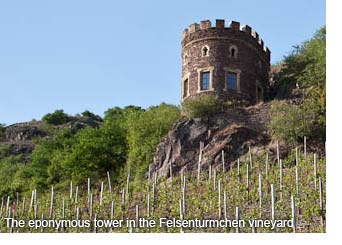 Heavenly wines from the Path to Hell
Heavenly wines from the Path to Hell

And other vineyards…
The Upper River Nahe meanders past steep slopes and precipitous vineyards, and on these slopes, between the villages of Oberhausen and Bad Kreuznach, the Dönnhoffs cultivate vines. They haven't chosen such difficult-to-work sites for fun (Höllenpfad, after all, means "path to hell") but rather because the slopes offer a combination of exposure and geologically diverse, complex soils which translate into complexity in the fruit and so, eventually, the wine. It works; in fact, they've been making wine here since the 1750s. They are now regarded as not only the Nahe's finest producer, but clearly among Germany's very greatest.
With vineyards on both sides of the Nahe having quite different aspects and microclimates, the Dönnhoffs are able to produce dazzling wines in a variety of styles. The gentle slopes and deep soils of the Kahlenberg vineyard do well with dry styles, while sheltered sites lend themselves to sweeter styles. The slate-soil, south-eastern facing Leistenberg vineyard basks in the morning sun, and with less afternoon exposure is ideal for kabinett; just across the river, the small Brücke vineyard can produce exquisite spätlese. Two bends of the river away, the Norheimer vineyards are the oldest recorded on the Nahe. Wild cherries grow among the vines here and are said to mark the character of the wine. The Grosses Gewachs (great growths) are the most complex, age-worthy dry wines from the very best sites.
2016 began with a cool, wet spring. Careful canopy management laid the ground for when the rains stopped and the long, hot, bountiful summer that followed. The resulting wines are elegant and racy, terroir-expressive, with the structure to live long. Cornelius Dönnhoff considers them on a par with the stunning 2015s. /NT
Offered subject to remaining unsold; available immediately
| Vintage | Description | Cs Sz | Bt Sz | Cs | Bts | ||
|---|---|---|---|---|---|---|---|
| 2016 | Donnhoff Kabinett Oberhauser Leistenberg | 6x | 75cl | 0 | 0 | Buy | |
| 2016 | Donnhoff Riesling QbA (fruity style) | 6x | 75cl | 0 | 0 | Buy | |
| 2016 | Donnhoff Spatlese Oberhauser Brucke | 6x | 75cl | 0 | 0 | Buy | |
| 2016 | Donnhoff Spatlese Nieder Hermannshohle | 6x | 75cl | 0 | 0 | Buy | |
| 2016 | Donnhoff Spatlese Norheimer Kirschheck | 6x | 75cl | 0 | 0 | Buy | |
| 2016 | Donnhoff Norheimer Dellchen GG | 6x | 75cl | 0 | 0 | Buy | |
| 2016 | Donnhoff Schlss Felsenberg Turmchen GG | 6x | 75cl | 0 | 0 | Buy | |
| 2016 | Donnhoff Kreuznacher Kahlenberg Dry | 6x | 75cl | 0 | 0 | Buy | |
| 2016 | Donnhoff Kreuznacher Kahlenberg Dry | 3x | 150cl | 0 | 0 | Buy | |
| 2016 | Donnhoff Tonschiefer Dry Slate Riesling | 6x | 75cl | 0 | 0 | Buy |